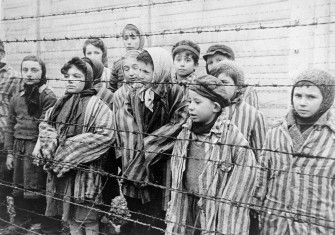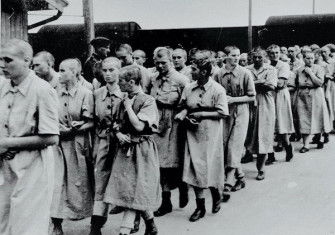Cambodia’s Crimes Unpunished
Confronting the country's darkest hour and looking for answers.

To be Cambodian is to have one’s life touched by the Khmer Rouge. The regime was in power for just three years, eight months and 20 days, but was responsible for an estimated 1.7 million deaths, about a quarter of the population. Forty years after its fall in January 1979, the scars are visible. It is rare to meet people who did not suffer some horror or inherit family trauma.
How to tell the story of a regime that unmade countless lives? In When the Clouds Fell From the Sky, journalist Robert Carmichael traces the history writ large from the lens of a single victim, Ouk Ket. In June 1977, Ket left his French wife and two young children in Paris to return to Cambodia. After almost a decade abroad – as a student and then a diplomat – Ket had built a life away from the civil war and US bombing that tore the country apart in the early 1970s. When the Khmer Rouge took control in April 1975, Cambodia went silent. Refugees who escaped to Thailand or Vietnam told stories of the regime’s brutality, but made little impression on a world stage. When the foreign ministry requested Ket and numerous other expatriate Cambodians return home, many did.
‘Come to Cambodia to get educated to better fulfil your responsibilities’, the letter read. Like many of his compatriots, Ket was a patriot. The opportunity to reunite with his parents and siblings and to help rebuild his nation proved irresistible. ‘He went back in that state of mind, in full confidence’, his wife, Martine, told Carmichael, three decades later.
Though his family would not learn it for years, Ket’s hopes were shattered upon landing in Phnom Penh. Drawing from surviving returnees’ accounts, Carmichael describes what the journey would have been like. He was sent almost immediately to S-21, the regime’s security centre, reserved for enemies of the state. He was imprisoned for six months, starved, tortured and forced to confess an absurd litany of crimes. He was executed on 9 December.
Though inspired by Mao Zedong’s interpretation of Marxism, the radical communist state pursued by Pol Pot had scant historical antecedent. Democratic Kampuchea was to be an agrarian utopia, an ethnocentric nation in which Cambodians would tap into the same innate Khmer genius that had allowed their ancestors to build the temples of Angkor Wat. On 17 April 1975, Phnom Penh fell to the Khmer Rouge, which set about dismantling governmental and social structures, scattering the population in one of the largest forced population movements in modern history.
This did not happen in a vacuum. Though Cambodia was not involved in the Vietnam War, in the preceding years the US dropped an estimated 500,000 tons of explosives on the country, hoping to rout North Vietnamese forces. Amid that turmoil, a coup replaced the prime minister Norodom Sihanouk (who had given up his throne to take political office), with the corrupt, US-supported general Lon Nol. Civil war broke out and Sihanouk aligned himself with the Khmer Rouge guerrillas, which brought them wide support. When the Khmer Rouge took Phnom Penh, many celebrated.
In the early 2000s, just a few years after the last of the Khmer Rouge formally surrendered, domestic and international pressure began mounting for a judicial reckoning. It took years of political and legal wrangling. Cambodia’s prime minister, Hun Sen, was a junior Khmer Rouge commander who defected to Vietnam the same year as Ket’s return. The nation’s two other leaders, Chea Sim (who died in 2015) and Heng Samrin, took similar paths to power. Beneath them, countless members of the ruling party – not to mention the hundreds of thousands given amnesty as part of the 1997 surrender agreement – had served the Khmer Rouge.
Any court that takes on crimes against humanity will invariably be limited in scope. But none have been anywhere near as limited as Cambodia’s. The Extraordinary Chambers in the Courts of Cambodia were established in 2006. Only two trials of the five ‘most responsible’ or senior leaders have gone forward. Two more investigations of four mid-level commanders, have stalled. The government, which counts among its highest ranks a number of Khmer Rouge defectors, was adamant that no cases past the first two would proceed. After death removed one defendant and dementia another, just three people – leaders Nuon Chea and Khieu Samphan, and S-21 jailer Kaing Guek Eav, alias ‘Duch’ – have been held to account for the crimes of the regime.
Few journalists have studied the Khmer Rouge tribunal as closely as Carmichael, whose book reveals the complex, often contradictory nature of international justice. What justice can be had when weighed against such crimes? It is an issue victims and observers alike have struggled with from the start. For a number of years Carmichael and I sat side by side in the tribunal’s press room. When I read his book years after the trial finished, it felt like an answer of sorts. The book is like tracing paper, layering Ket’s life over Cambodia’s sad history. Threading it together are Martine and Ket’s daughter Neary, whose early chance encounter with Carmichael yielded this extraordinary story.
Duch’s trial was straightforward. The jailer was no ideologue, instead he was the ideal bureaucrat. A former schoolteacher, he possessed an almost pathological eagerness to please. Duch’s meticulous record keeping, which detailed the entry and execution date of each prisoner, and insistence on written confessions supplied the court with reams of evidence concerning the murder of at least 12,000 people.
The court scenes are riveting. Duch claims to be very sorry, a repentance few of his victims credit and which is repeatedly undermined by his insistence he was just doing his job. For Martine and Neary, who travelled to Cambodia to give testimony at a deeply imperfect court, confronting Duch provides a chance few victims will have. After Martine recounts her hunt for her husband – chasing down Chinese and Cambodian officials, scraping together funds to visit the distended refugee camps on the Thai border in 1979 only to learn he had died years earlier – she speaks of the pain his absence has wrought on her and her family: ‘They destroyed our life.’ When Duch offers his platitudinous response, Martine removes her headphones. ‘It unnerves Duch’, Carmichael deftly observes. Neary describes visiting S-21, which became a museum in the early 1980s, for the first time as a teenager. ‘How can such a shiny man finish in such a dark place?’ she later asks.
In Buried, British photojournalist Charles Fox explores the same questions from a different angle. Like Carmichael, Fox worked with a Cambodian family – the Ramas – to tell a story that is both extraordinary and ordinary.
When the Khmer Rouge took over, Ky Kim Pean buried her family’s photos behind their Battambang home. Reproduced in Buried, the album, of course, has a missing middle. The photographs stop in the mid-1970s and resume in 1981, with the family registered at a Thai refugee camp before travelling to the US. Kim Pean’s husband died, but she and all seven of her children survived. The life we see them build as newly minted American citizens is moving. The buried photos – the family at the beach, the father as a stylish teenager – show signs of age. The newer ones are remarkable in their banality. Vira as a teenage boy, ‘hanging out with high school friends’, five years after escaping the Khmer Rouge. Eight-year-old Chandra and five-year-old Kamala dressed for church just after arriving in the US. For the Rama family, leaving Cambodia appears to have helped them move on. Ket’s daughter Neary seeks to do the same. One afternoon, she visits S-21 and begins writing a message for her father on the wall of his cell: ‘We are leaving.’
When the Clouds Fell from the Sky: A Daughter’s Search for Her Father in the Killing Fields of Cambodia
Robert Carmichael
Little, Brown 368pp £20
Buried
Charles Fox
Catfish 48pp £20
Abby Seiff is a journalist covering religion, politics and the environment in Southeast Asia.






